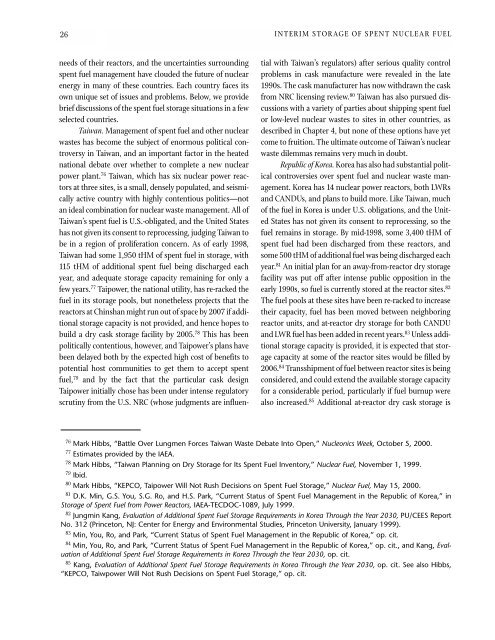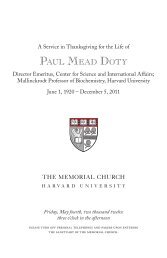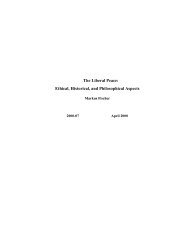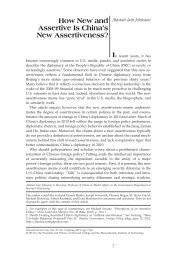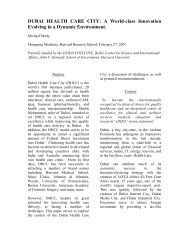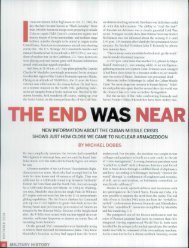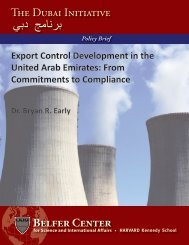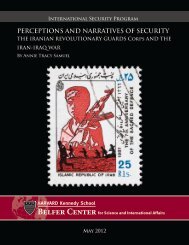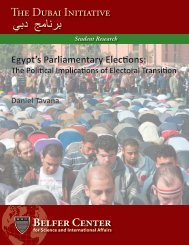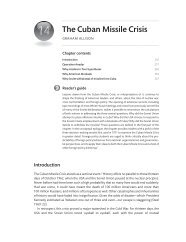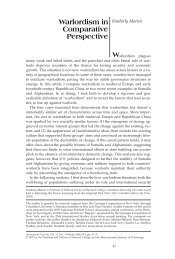Interim Storage of Spent Nuclear Fuel - Woods Hole Research Center
Interim Storage of Spent Nuclear Fuel - Woods Hole Research Center
Interim Storage of Spent Nuclear Fuel - Woods Hole Research Center
Create successful ePaper yourself
Turn your PDF publications into a flip-book with our unique Google optimized e-Paper software.
26<br />
needs <strong>of</strong> their reactors, and the uncertainties surrounding<br />
spent fuel management have clouded the future <strong>of</strong> nuclear<br />
energy in many <strong>of</strong> these countries. Each country faces its<br />
own unique set <strong>of</strong> issues and problems. Below, we provide<br />
brief discussions <strong>of</strong> the spent fuel storage situations in a few<br />
selected countries.<br />
Taiwan. Management <strong>of</strong> spent fuel and other nuclear<br />
wastes has become the subject <strong>of</strong> enormous political controversy<br />
in Taiwan, and an important factor in the heated<br />
national debate over whether to complete a new nuclear<br />
power plant. 76 Taiwan, which has six nuclear power reactors<br />
at three sites, is a small, densely populated, and seismically<br />
active country with highly contentious politics—not<br />
an ideal combination for nuclear waste management. All <strong>of</strong><br />
Taiwan’s spent fuel is U.S.-obligated, and the United States<br />
has not given its consent to reprocessing, judging Taiwan to<br />
be in a region <strong>of</strong> proliferation concern. As <strong>of</strong> early 1998,<br />
Taiwan had some 1,950 tHM <strong>of</strong> spent fuel in storage, with<br />
115 tHM <strong>of</strong> additional spent fuel being discharged each<br />
year, and adequate storage capacity remaining for only a<br />
few years. 77 Taipower, the national utility, has re-racked the<br />
fuel in its storage pools, but nonetheless projects that the<br />
reactors at Chinshan might run out <strong>of</strong> space by 2007 if additional<br />
storage capacity is not provided, and hence hopes to<br />
build a dry cask storage facility by 2005. 78 This has been<br />
politically contentious, however, and Taipower’s plans have<br />
been delayed both by the expected high cost <strong>of</strong> benefits to<br />
potential host communities to get them to accept spent<br />
fuel, 79 and by the fact that the particular cask design<br />
Taipower initially chose has been under intense regulatory<br />
scrutiny from the U.S. NRC (whose judgments are influen-<br />
INTERIM STORAGE OF SPENT NUCLEAR FUEL<br />
tial with Taiwan’s regulators) after serious quality control<br />
problems in cask manufacture were revealed in the late<br />
1990s. The cask manufacturer has now withdrawn the cask<br />
from NRC licensing review. 80 Taiwan has also pursued discussions<br />
with a variety <strong>of</strong> parties about shipping spent fuel<br />
or low-level nuclear wastes to sites in other countries, as<br />
described in Chapter 4, but none <strong>of</strong> these options have yet<br />
come to fruition. The ultimate outcome <strong>of</strong> Taiwan’s nuclear<br />
waste dilemmas remains very much in doubt.<br />
Republic <strong>of</strong> Korea. Korea has also had substantial political<br />
controversies over spent fuel and nuclear waste management.<br />
Korea has 14 nuclear power reactors, both LWRs<br />
and CANDUs, and plans to build more. Like Taiwan, much<br />
<strong>of</strong> the fuel in Korea is under U.S. obligations, and the United<br />
States has not given its consent to reprocessing, so the<br />
fuel remains in storage. By mid-1998, some 3,400 tHM <strong>of</strong><br />
spent fuel had been discharged from these reactors, and<br />
some 500 tHM <strong>of</strong> additional fuel was being discharged each<br />
year. 81 An initial plan for an away-from-reactor dry storage<br />
facility was put <strong>of</strong>f after intense public opposition in the<br />
early 1990s, so fuel is currently stored at the reactor sites. 82<br />
The fuel pools at these sites have been re-racked to increase<br />
their capacity, fuel has been moved between neighboring<br />
reactor units, and at-reactor dry storage for both CANDU<br />
and LWR fuel has been added in recent years. 83 Unless additional<br />
storage capacity is provided, it is expected that storage<br />
capacity at some <strong>of</strong> the reactor sites would be filled by<br />
2006. 84 Transshipment <strong>of</strong> fuel between reactor sites is being<br />
considered, and could extend the available storage capacity<br />
for a considerable period, particularly if fuel burnup were<br />
also increased. 85 Additional at-reactor dry cask storage is<br />
76 Mark Hibbs, “Battle Over Lungmen Forces Taiwan Waste Debate Into Open,” Nucleonics Week, October 5, 2000.<br />
77 Estimates provided by the IAEA.<br />
78 Mark Hibbs, “Taiwan Planning on Dry <strong>Storage</strong> for Its <strong>Spent</strong> <strong>Fuel</strong> Inventory,” <strong>Nuclear</strong> <strong>Fuel</strong>, November 1, 1999.<br />
79 Ibid.<br />
80 Mark Hibbs, “KEPCO, Taipower Will Not Rush Decisions on <strong>Spent</strong> <strong>Fuel</strong> <strong>Storage</strong>,” <strong>Nuclear</strong> <strong>Fuel</strong>, May 15, 2000.<br />
81 D.K. Min, G.S. You, S.G. Ro, and H.S. Park, “Current Status <strong>of</strong> <strong>Spent</strong> <strong>Fuel</strong> Management in the Republic <strong>of</strong> Korea,” in<br />
<strong>Storage</strong> <strong>of</strong> <strong>Spent</strong> <strong>Fuel</strong> from Power Reactors, IAEA-TECDOC-1089, July 1999.<br />
82 Jungmin Kang, Evaluation <strong>of</strong> Additional <strong>Spent</strong> <strong>Fuel</strong> <strong>Storage</strong> Requirements in Korea Through the Year 2030, PU/CEES Report<br />
No. 312 (Princeton, NJ: <strong>Center</strong> for Energy and Environmental Studies, Princeton University, January 1999).<br />
83 Min, You, Ro, and Park, “Current Status <strong>of</strong> <strong>Spent</strong> <strong>Fuel</strong> Management in the Republic <strong>of</strong> Korea,” op. cit.<br />
84 Min, You, Ro, and Park, “Current Status <strong>of</strong> <strong>Spent</strong> <strong>Fuel</strong> Management in the Republic <strong>of</strong> Korea,” op. cit., and Kang, Evaluation<br />
<strong>of</strong> Additional <strong>Spent</strong> <strong>Fuel</strong> <strong>Storage</strong> Requirements in Korea Through the Year 2030, op. cit.<br />
85 Kang, Evaluation <strong>of</strong> Additional <strong>Spent</strong> <strong>Fuel</strong> <strong>Storage</strong> Requirements in Korea Through the Year 2030, op. cit. See also Hibbs,<br />
“KEPCO, Taiwpower Will Not Rush Decisions on <strong>Spent</strong> <strong>Fuel</strong> <strong>Storage</strong>,” op. cit.


